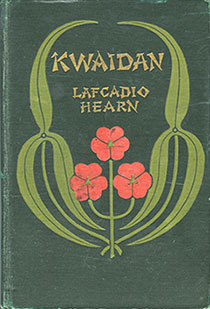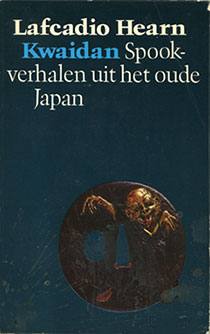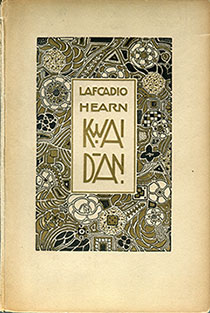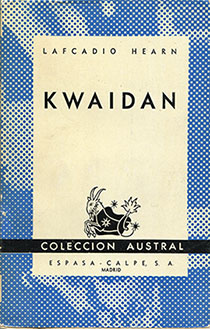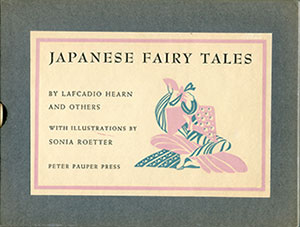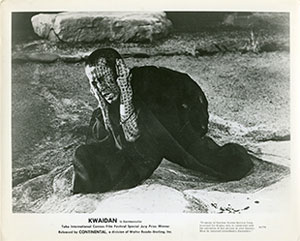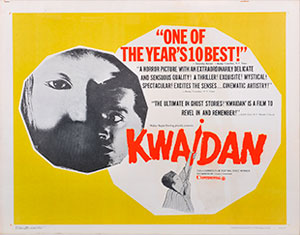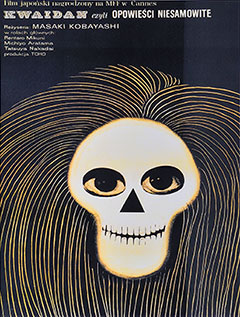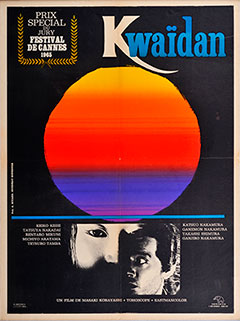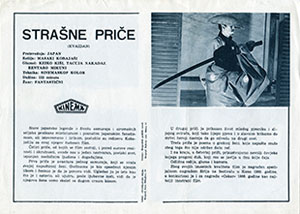Lafcadio Hearn
‘KWAIDAN’ Exhibition
The Special Collection of Books and Film
Lafcadio Hearn Memorial Museum
Sunday, June 26, 2011 – Tuesday, March 20, 2012
Organizer: Lafcadio Hearn Memorial Museum
Co-Organizer: Matsue City
Sponsor: The Hearn Society
Extention of the exhibition “Lafcadio Hearn KWAIDAN – The Special Collection of Books and Film”
The exhibition “Lafcadio Hearn KWAIDAN – The Special Collection of Books and Film” which is being held at the Lafcadio Hearn Memorial Museum will be extended until March 20, 2012 due to its popularity. We are looking forward to meeting you on the site.
Intent
The words ‘Kwaidan’ and Lafcadio Hearn (Koizumi Yakumo) are rarely seen one without the other. And Hearn is known in Japan primarily through this association. Sales of Hearn’s earlier publications (from 120 years ago), right up to more recent editions continue to sell strongly in online auctions and web sales. Printing even continues to meet this demand. This unfading interest in Hearn is not limited to Japan. He also has a growing overseas following, with KWAIDAN topping the sales list.
So how does ‘Kwaidan’ maintain its appeal 120 years on?
The search to answer this anomaly is the ‘Kwaidan’ exhibition’s central theme. The exhibition is a search for the significance of and how ‘Kwaidan’ may be integrated into today’s society.
Hearn took his hand at penning in various literary genres (e.g. novels, prose poetry, travelogues, folktales retold, etc…), but whatever else may be true about him, his eloquence and simplicity of expression in narrative writing is undeniable. Hearn’s finest attribute lay in his retelling folktales in his personal aesthetically descriptive style. This attribute is evident in both KWAIDAN and KOTTO, where he took folklore and traditional tales as the basis for his books, and made them his own through a very characteristically Hearn writing style. In doing so, he brought about ‘Saiwa’ literature (Folktales retold lit.). Hearn did not simply choose bizarre ghost stories as his subject to work on just to play the eccentric artist. Rather, he used this retelling of traditional ghost stories as a vehicle for posing questions about humanity, for questioning how we should live, and questioning the essence of the spirit and the soul. Through his writing Hearn posed these questions to us, the readers. (Ghost stories & Fairy tales, Chikuma Publications, Ikeda Masayuki)
Hearn himself also commented that within ghost stories there is a hidden truth, and that and also that these eccentricities, curiosities, bizarre other worldly things which he was more than happy to be immersed in, suited his personality. He revealed these thoughts in letters he wrote as a youth to friends.
This exhibition will focus primarily on works such as KWAIDAN, KOTTO, and In Ghostly Japan, all of which fall under Hearn’s folktales retold literary genre. It is an investigation into the nature of this so called folktales retold literary field.
Within the exhibition, publications of KWAIDAN and other books will displayed in various languages. It is the rarity of some of these translations that clearly demonstrates the widespread appreciation of Hearn’s writings. As a further indication of Hearn’s international reception with the release of ‘Kwaidan’, posters fromthe film will also be exhibited as they were produced in each respective country. This poster display, in addition to the other formats on display, provides another route to seeing how Hearn’s works were received on a global scale.
In recent years in Japan, there has been somewhat of a ‘spiritual’ boom. So called ‘power spots’, have been enjoying a new found popularity amongst the Japanese youth, and it seems that more and more of today’s youth are turning to the spiritual world in search of happiness, rather than science, technology, and the material world. In this vein, ‘Kwaidan’ may hold a valuable message for the modern world.
A large part of the work that went into KWAIDAN, was listening to and putting to use the stories Setsu (Hearn’s wife) told him. He himself recognised how important a role she played in the books’ creation, praising her as “the best wife in the world”, remembering to honour her for her contribution. The extent to which Hearn valued Setsu's storytelling, (even more than lexical meaning), is evident in the title KWAIDAN itself. Rather than translating and replacing kwaidan with ‘ghost stories’ etc, Hearn retained the Japanese, in Setsu’s direct pronunciation of her local Izumo dialect. We are also hoping that this exhibition will draw attention to Setsu role, and thus provide impetus for the re-evaluation of Matsue’s very own talented storyteller.
Details
The exhibition addresses the field of Hearn’s global reception and evaluation. In order to explore this area, one of the aspects that we will look at will be the various languages into which KWAIDAN (Houghton, Mifflin & Co. 1904) was subsequently translated into. It’s little surprise that there were French and German translations of the publication, but it was also translated into Turkish, Polish, Italian, Chinese, Spanish, Danish, etc. What’s even more interesting to note is a rare publication of a picture book version of Hearn’s Japanese Fairy Tales which has been translated into Inuit. A definitive figure has yet to be put on the number of translations of Hearn’s works, suffice to say that curiosity in the ‘spirit world’ seems to span generations and countries alike.
The film adaptation “KWAIDAN” first opened in 1964. As director Kobayashi Masaki’s major production, he presented Hearn’s original work in omnibus format. Lasting a lengthy three hours, it was the first colour adaptation and portrayed a fantastical world pushing the bounds of what we expect from the real world. Masaki’s production of “KWAIDAN” was not only nominated for the Academy Film Award’s best foreign film, it also received the Cannes International Film Festival Special Award as designated by a panel of judges. “KWAIDAN” received rave reviews and was considered to be a masterpiece, leading the way in Japanese filmography.
As a result of receiving the prestigious title of Cannes International film festival award winner, “KWAIDAN” went on to be screened in dozens of countries around the world, each with it’s own poster. These posters subsequently went on sale through online auction and web bookstores, avid collectors getting their hands on the various versions. We will be displaying those very posters, from France, America, Argentina, Yugoslavia, Poland, etc. In addition, the DVD and VHS production of the American and Chinese versions will also be on display.
It is thanks to the good will and favour of one Takis Efstathiou that we will be able to enjoy this insight into Hearn’s reception through various fields of production worldwide. Efstathiou is an Art Coordinator living in Greece, and having loaned his collection for this exhibition, we can now offer many people a once in a life time chance to view his rare collection.
Superviser: Koizumi Bon
Coordinator: Koizumi Shoko
Designer: Ishikawa Kiyoharu
Collection of Takis Efstathiou

